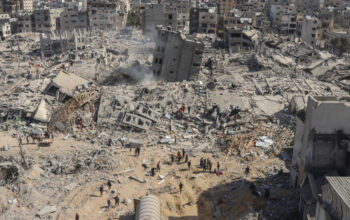
If there’s one thing to understand about the Ukrainian refugee crisis in Poland, it’s this: Approximately 90 percent of the refugees are women and children.
Because of military conscription, Ukraine has barred most men between 18 and 60 from leaving. So although millions of people have fled the Russian invasion, the ones who cross the border are women, children, and some older men.
That has meant devastating separations for the families involved. But it also means that this crisis of forced migration is foremost a crisis for women — particularly for mothers.
A world of women
To understand how that crisis is playing out, I went to Zabki, a small suburb outside Warsaw, which exemplifies the promise and challenges of Poland’s effort to welcome Ukrainian refugees.
The first refugees arrived within days of the Russian invasion, said Malgorzata Zysk, the town’s mayor. Officially, more than 1,500 Ukrainian refugees now live in Zabki, with about 100 registering each day. But Zysk estimated that the real numbers are about twice as high.
In a small apartment lent to her by Zabki’s government, Lubomira Pancuk showed me photographs of her family gathered in January for Orthodox Christmas. In the pictures, she is pregnant, next to her husband and three daughters, all smiling for the camera. “We were all together, happy, waiting for the baby,” she said.
Less than two months later, the war forced her to flee to Poland with her children, including her three-week-old son, who was born prematurely and has jaundice. Her husband is still in Ukraine.
Pancuk’s eyes filled with tears as she described the generosity of Zabki’s government and residents.
But the family lives precariously, reliant on a small allowance from the Polish government and the generosity of their Polish neighbors. It is impossible for Pancuk to work because she must care for her baby.
“I don’t know what my plans will be,” she said. “I am just living day to day.”
It’s a story that I heard over and over from women refugees in Poland. They told me that their priorities were simple: a safe place to live with their children, far from the bombs and battles.
But security and stability often cost more than the small allowance the Polish government offers to Ukrainian families. Though thousands of Polish citizens have lent refugees rooms or apartments, soon many refugee mothers will have to work to pay the rent.
That means Ukrainian mothers must solve a higher-stakes version of the problem that working mothers face all over the world: how to find both affordable child care and employers willing to accommodate their needs as parents.
A system under strain
Family-friendly policies, such as flexible working hours, are relatively rare in Polish workplaces — the legacy of years of high unemployment.
Care for children under 3 is often so expensive that many women find it cheaper to stay home until their children are old enough for preschool. And although the government has expanded state-funded preschools for 3- to 6-year-olds as part of its nationalist campaign to convince Polish women to have more children, spaces were already in short supply in many parts of the country before the war began.
Grazyna Swiezak, the director of a preschool in Zabki, said that she and her staffers were happy for the opportunity to help Ukrainian children.
The school anticipates that some refugee children will need emotional support, and Swiezak said she hoped to find Ukrainian- or Russian-speaking psychotherapists to help them. But on my recent visit there, the scene seemed idyllic. In a row of sunlit classrooms, Ukrainian children played with new friends.
But good will cannot necessarily overcome institutional limitations. The caps on preschool class sizes, for instance, were intended to ensure that children had adequate supervision. Expanding them further could jeopardize children’s education, and perhaps their safety.
And the new spots created for Ukrainian children are filling up. More than half of the new spaces at the preschool are already taken, Swiezak said. New families arrive in town every day.
If the government expands support for Ukrainian mothers without making similar efforts to meet Polish women’s unmet needs, there is a risk of political backlash.
“Some people will have understanding for the fact that these people have suffered so much, and want to help them get safe footing in the Polish territory,” Iga Magda, a labor economist at the SGH Warsaw School of Economics, said. “But others will not care as much.”
“The last thing we need is a conflict here,” Magda told me. “This is what Putin wants the most, right?”
To read more from Amanda, sign up for the Interpreter newsletter.
More on Ukraine
THE LATEST NEWS
Subway Shooting
The celebrity bump
Rihanna was already an icon — she’s had more than a dozen chart-topping hits, is known for her trendsetting red-carpet looks, and founded hugely successful cosmetics and lingerie lines. Now, she’s changing what a celebrity pregnancy looks like.
What sets Rihanna’s maternity outfits apart is that they’re not so different from what she wore before. She has embraced her body throughout her pregnancy, showing up to events in sheer tops and bras, skintight dresses, and custom-made jumpsuits designed to flaunt her belly. Rihanna is showing that she is “autonomous, powerful and herself, even while carrying a life,” Renée Ann Cramer, author of “Pregnant With the Stars,” told The Times.
It’s a significant move considering that the pregnant body has long been “policed, hidden away and considered problematic,” our fashion critic Vanessa Friedman writes. Three decades ago, many stores banned an issue of Vanity Fair featuring a naked and pregnant Demi Moore on the cover. The photographer who snapped that cover, Annie Leibovitz, has now photographed Rihanna for the May issue of Vogue. Her outfit: a red lace bodysuit.
PLAY, WATCH, EAT
What to Cook
The pangram from yesterday’s Spelling Bee was quoting. Here is today’s puzzle — or you can play online.

